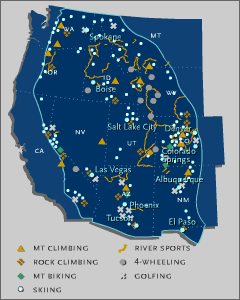 Land
of Enchantment, by Woody Crumbo, 1946
Land
of Enchantment, by Woody Crumbo, 1946American West - Tourism -- the Devil's Bargain
 Land
of Enchantment, by Woody Crumbo, 1946
Land
of Enchantment, by Woody Crumbo, 1946
Thirty-five years ago, Edward Abbey popularized the idea of "industrial tourism" in his famed book, Desert Solitaire. Many observers since have written of the transformation that follows a heavily-promoted, infrastructure and resource-dependent tourism.
You can see them cruising for Indian art in Santa Fe, waiting for Old Faithful at Yellowstone, or pausing for shrimp cocktails on San Francisco's Fisherman's Wharf. The American West attracts vacationers of every stripe, who comb its varied landscapes for the ultimate trip. And for better or worse, those who come to see this multifaceted region have changed what they have come to see.
The West is popularly perceived as America's last outpost of unfettered opportunity, but twentieth-century corporate tourism has transformed it into America's "land of opportunism." From Sun Valley to Santa Fe, towns throughout the West have been turned over to outsiders--and not just to those who visit and move on, but to those who stay and control.
Although tourism has been a blessing for many, bringing economic and cultural prosperity to communities without obvious means of support or allowing towns on the brink of extinction to renew themselves; the costs on more intangible levels may be said to outweigh the benefits and be a devil's bargain in the making.
The introduction of tourism into a community may seem innocuous, but residents gradually realize, as they seek to preserve the authenticity of their communities, that decision-making power has subtly shifted from the community itself to the newly arrived corporate financiers. And because tourism often results in a redistribution of wealth and power to "outsiders," it represents a new form of colonialism for the region.

The American economy as a whole now relies on services and information rather than industrial production. Westerners have turned to services too, but with a distinctive twist, catering to tourists in search of outdoor adventure. Skiers, hikers, fishers, mountain bikers, and golfers now power the local economies of dozens of Western towns.
(Source:
www.learner.org/.../
Reading:
Response topic: check out a tourism site for a western state. Report orally on the site in relation to Rothman's analysis of the Devil's Bargain
The West is popularly perceived as America's last outpost of unfettered opportunity, but twentieth-century corporate tourism has transformed it into America's "land of opportunism." From Sun Valley to Santa Fe, towns throughout the West have been turned over to outsiders--and not just to those who visit and move on, but to those who stay and control.
Although tourism has been a blessing for many, bringing economic and cultural prosperity to communities without obvious means of support or allowing towns on the brink of extinction to renew themselves; the costs on more intangible levels may be said to outweigh the benefits and be a devil's bargain in the making.
Tourism evolved from Grand Canyon rail trips to Sun Valley ski weekends and Disneyland vacations, and how the post–World War II boom in air travel and luxury hotels capitalized on a surge in discretionary income for many Americans, combined with newfound leisure time.
From major destinations like Las Vegas to revitalized towns like Aspen and Moab, the introduction of tourism into a community may seem innocuous, but residents gradually realize, as they seek to preserve the authenticity of their communities, that decision-making power has subtly shifted from the community itself to the newly arrived corporate financiers. And because tourism often results in a redistribution of wealth and power to "outsiders," it represents a new form of colonialism for the region. (Rothman, The Devil's Bargain, University of Kansas Press)
Internet Resources:
- American West Travelogue - Travel photographs and commentary on destinations in the American West. Includes a "best of the west" directory, feature stories, hiking pages, and links. Focus is on outdoor recreation, but also covers cultural, historical, and lifestyle topics.
- Attractions and Hikes of the West - Features general travel tips, information about local parks, and map of the west. Page includes photos.
- California Deserts - Introduces the approximately 25 million acres of desert located in California and southern Nevada. Highlights recreational, educational, and cultural opportunities and offers suggestions about planning a trip, including safety tips and weather information.
- Go American West - Travel resources, trip planning information, forum, photo galleries, maps, and links.
- Mountain Lifestyles - Offers travel information for mountain locations in New Mexico, Wyoming and Colorado.
- Pacific101 - Travel and accommodation directory for California, Oregon, and Washington.
- Pacific West Information Center - Provides information about National Parks located in Hawaii, California, Washington, Oregon, Idaho, Nevada, and part of Montana.
- Travel West Visual - Visual Portal for destinations and travel points in the western part of North America, including Canada and the United States. Includes destination maps, basic information and links.
- Western National Parks Association - Information on the 63 National Park Service sites served by WNPA, in eleven western states. Educational publications, field guides, kid's books available in an online store.